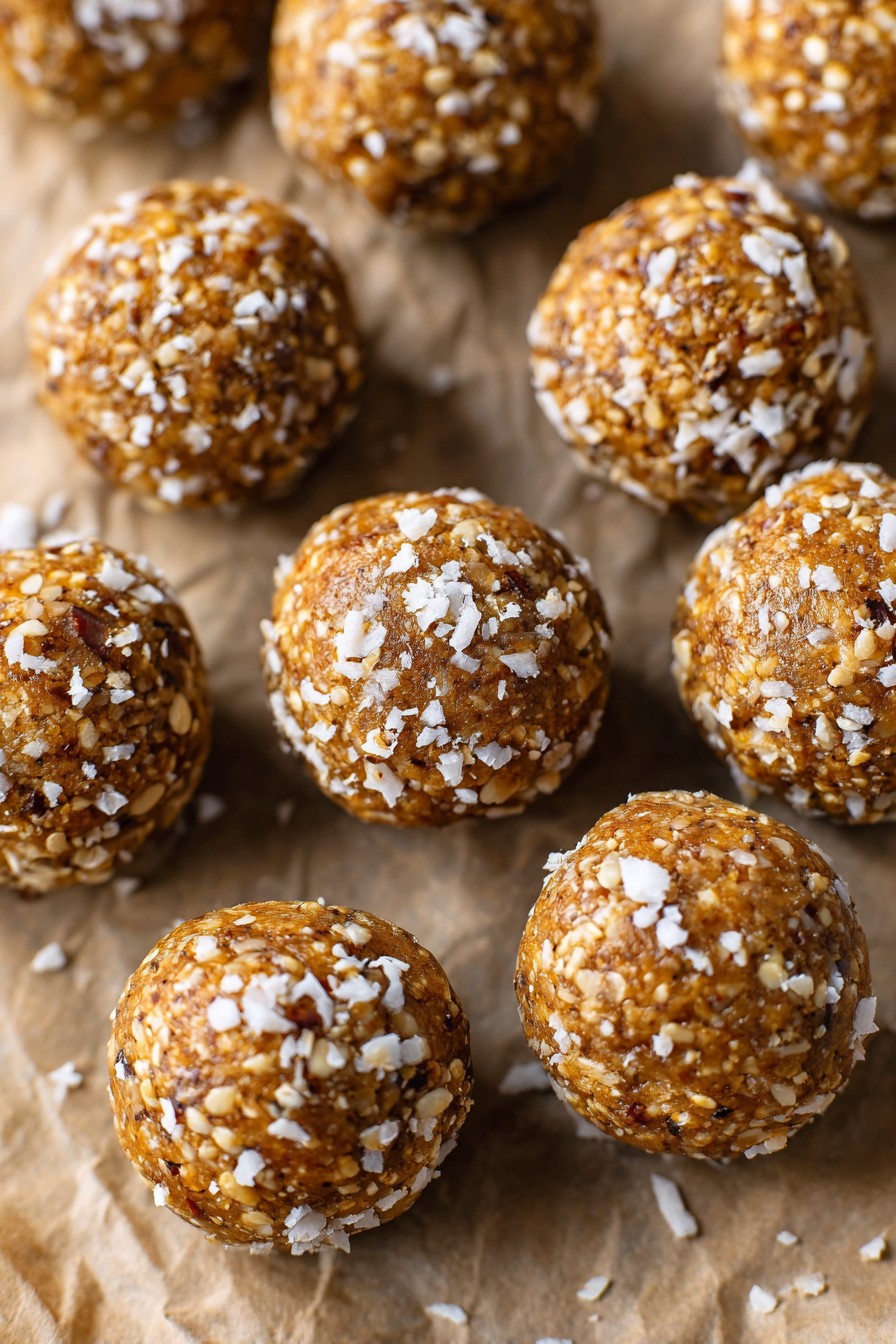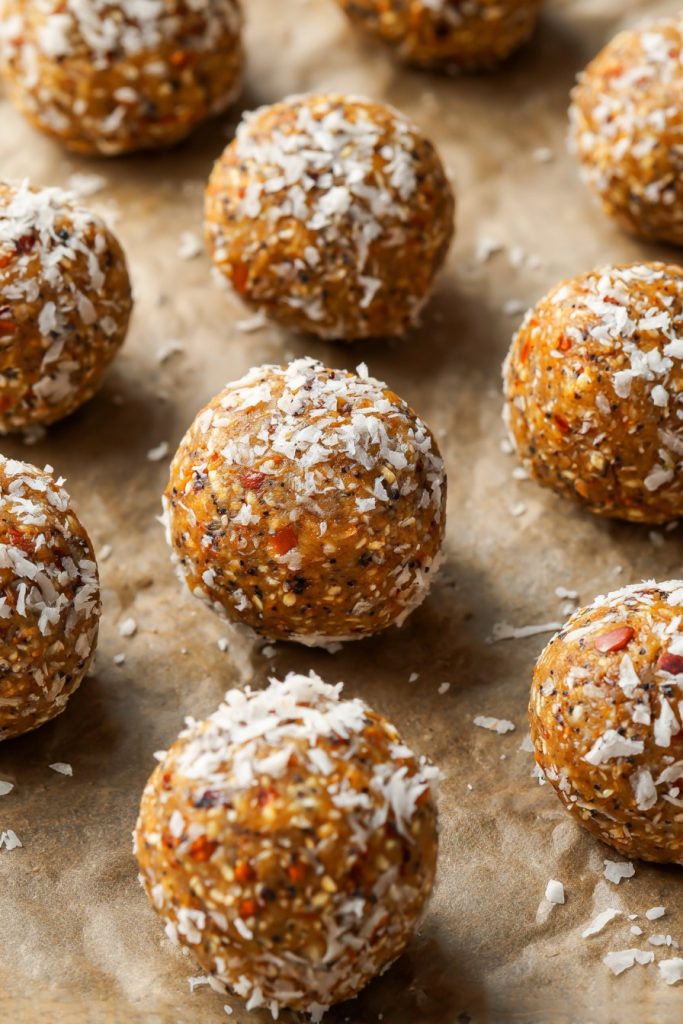Starting your day with nutritious snacks doesn’t have to be complicated or time-consuming. Satisfying your sweet tooth while maintaining low carbohydrate intake is achievable with these protein-packed peanut butter balls that deliver sustained energy without blood sugar spikes. Simple ingredients come together to create portable snacks perfect for busy lifestyles and health-conscious eating.
Why This Recipe Works
- Natural peanut butter provides healthy monounsaturated fats and protein that promote satiety and stable energy levels, while its creamy texture binds the ingredients without requiring additional sweeteners or processed binders that would increase carbohydrate content unnecessarily.
- Almond flour serves as the perfect low-carb alternative to traditional wheat flour, contributing only 3 grams of net carbohydrates per quarter cup while adding valuable fiber, vitamin E, and essential minerals that support metabolic health and digestive function.
- Unsweetened shredded coconut delivers texture and healthy medium-chain triglycerides that the body can readily convert to energy, along with manganese and antioxidants that support cellular health and provide natural sweetness without added sugars.
- Ground flaxseed introduces omega-3 fatty acids and lignans that support heart health and hormonal balance, while the soluble fiber content helps regulate blood sugar response and promotes digestive regularity without affecting the delicious peanut butter flavor profile.
- The minimal sweetening from sugar-free maple syrup or monk fruit sweetener keeps net carbohydrates under 3 grams per serving while satisfying cravings, making these balls suitable for ketogenic, diabetic, and general low-carb eating plans.
Ingredients
- 1 cup natural creamy peanut butter (unsweetened, no added oils)
- 1/2 cup almond flour (blanched, finely ground)
- 1/4 cup unsweetened shredded coconut
- 1/4 cup ground flaxseed
- 3 tablespoons sugar-free maple syrup or monk fruit sweetener
- 1 teaspoon pure vanilla extract
- 1/2 teaspoon sea salt
- 2 tablespoons coconut oil (melted)
Equipment Needed
- Medium mixing bowl
- Measuring cups and spoons
- Rubber spatula
- Baking sheet
- Parchment paper
- Small cookie scoop or tablespoon
- Airtight storage container
Instructions

Prepare Your Ingredients and Workspace
Begin by gathering all ingredients and ensuring your peanut butter is well-stirred if separation has occurred, as natural peanut butter tends to separate with the oils rising to the top. Measure the almond flour precisely using the spoon-and-level method to avoid compacting, which could result in dry balls that crumble easily. The almond flour provides not only structure but also valuable nutrients including vitamin E, magnesium, and healthy fats that support metabolic health. Have your melted coconut oil ready but not hot, as excessive heat can cause the peanut butter to become too runny and affect the final texture. Pro tip: If your kitchen is particularly warm, consider chilling your mixing bowl for 15 minutes before beginning to help the mixture firm up more quickly during preparation.
Combine Dry Ingredients Thoroughly
In your medium mixing bowl, add the almond flour, unsweetened shredded coconut, ground flaxseed, and sea salt, then whisk these dry ingredients together for approximately 30 seconds until evenly distributed and no clumps remain. The whisking action not only combines ingredients but also aerates the mixture, resulting in lighter textured balls that melt pleasantly in your mouth rather than feeling dense or heavy. Pay particular attention to breaking up any lumps in the almond flour, as these can create uneven texture in your final product. The sea salt enhances flavor perception and helps balance the natural bitterness that can sometimes accompany sugar-free sweeteners, creating a more rounded flavor profile. This thorough mixing ensures each ball receives equal distribution of the coconut’s texture, flaxseed’s nutritional benefits, and almond flour’s binding properties.
Incorporate Wet Ingredients and Sweetener
Add the natural peanut butter, sugar-free maple syrup or monk fruit sweetener, pure vanilla extract, and melted coconut oil to the dry mixture. Using a rubber spatula, fold and press the ingredients together until a uniform dough forms, which should take about 2-3 minutes of consistent mixing. The dough should be slightly sticky but hold its shape when pressed together – if it appears too dry, add another teaspoon of melted coconut oil; if too wet, add another tablespoon of almond flour. The coconut oil solidifies when chilled, creating the perfect firm texture while contributing medium-chain triglycerides that support energy production and cognitive function. Pro tip: For optimal flavor development, allow the mixed dough to rest for 5 minutes before portioning, as this gives the almond flour time to fully absorb the moisture and results in better texture.
Portion and Shape the Energy Balls
Using a small cookie scoop or tablespoon, portion heaping tablespoons of the mixture and roll between your palms to form smooth, round balls approximately 1 inch in diameter. Apply gentle but firm pressure when rolling to ensure the balls hold their shape without being overly compacted, which could make them dense and difficult to digest. If the mixture becomes too soft or sticky from the warmth of your hands, chill it in the refrigerator for 10-15 minutes before continuing. Place the formed balls on a parchment-lined baking sheet, spacing them about 1 inch apart to allow for air circulation during the chilling process. This portion size provides the perfect balance of protein, healthy fats, and minimal carbohydrates for sustained energy without blood sugar spikes.
Chill to Set Perfect Texture
Transfer the baking sheet with formed peanut butter balls to the refrigerator and chill for at least 45 minutes, or until firm to the touch. The chilling process allows the coconut oil to solidify and the ingredients to fully hydrate, creating the ideal chewy yet firm texture that makes these balls portable and mess-free. For longer storage, you can transfer the chilled balls to an airtight container, where they will maintain their texture for up to two weeks refrigerated or one month frozen. Pro tip: For individual portion control and easy grabbing, consider placing parchment paper between layers if stacking in your storage container to prevent sticking and maintain perfect shape.
Tips and Tricks
For optimal texture and flavor development, consider toasting your almond flour in a dry skillet over medium heat for 3-4 minutes until fragrant before using it in the recipe. This toasting process enhances the nutty flavor profile and reduces any raw taste that might otherwise be noticeable in the final product. When selecting peanut butter, read labels carefully to ensure no added sugars or hydrogenated oils are present – the ingredient list should contain only peanuts and possibly salt. If your mixture seems too dry despite proper measurements, this often indicates that your peanut butter has less natural oil content; simply add additional melted coconut oil one teaspoon at a time until the desired consistency is achieved. Conversely, if your mixture appears too wet and sticky, this typically means your peanut butter has higher oil content or your kitchen environment is particularly warm; add additional almond flour one tablespoon at a time until the dough holds its shape when rolled. For those monitoring carbohydrate intake precisely, consider using powdered erythritol or allulose instead of sugar-free maple syrup, using approximately 1/4 cup plus 1 tablespoon to achieve similar sweetness and texture. If you prefer crunchier texture, add 2 tablespoons of chopped peanuts or sugar-free chocolate chips during the final mixing stage, being mindful that this will slightly increase the carbohydrate count. For enhanced nutritional profile, consider replacing 2 tablespoons of almond flour with collagen peptides or unflavored protein powder, which will increase the protein content without significantly altering flavor or texture. When storing, always use airtight containers and consider including a silica gel packet to absorb excess moisture in humid environments, which helps maintain the ideal texture throughout the storage period.
Recipe Variations
- Chocolate Peanut Butter Version: Replace 2 tablespoons of almond flour with unsweetened cocoa powder and add 1/4 cup sugar-free chocolate chips for a decadent treat that satisfies chocolate cravings while maintaining low carbohydrate content. The cocoa powder adds antioxidants and magnesium while complementing the peanut butter flavor beautifully.
- Protein-Packed Adaptation: Incorporate 2 scoops of vanilla or unflavored collagen peptides or protein powder, reducing the almond flour by 2 tablespoons to accommodate the additional dry ingredients. This variation significantly increases the protein content to approximately 8 grams per ball, making it ideal for post-workout recovery or as a meal replacement option.
- Coconut Dominant Variation: Increase the unsweetened shredded coconut to 1/2 cup while reducing almond flour to 1/4 cup, creating a more pronounced coconut flavor and texture. You can also roll the finished balls in additional shredded coconut for enhanced visual appeal and textural contrast that makes them perfect for special occasions or guests.
- Spiced Autumn Edition: Add 1 teaspoon cinnamon, 1/4 teaspoon nutmeg, and 1/8 teaspoon cloves to the dry ingredients for a warming seasonal variation that pairs wonderfully with coffee or tea. These spices not only enhance flavor but provide additional antioxidants and anti-inflammatory compounds that support overall health during colder months.
- Seed Energy Boost: Replace the flaxseed with an equal combination of chia seeds and hemp hearts for different nutritional profile featuring complete protein from hemp and additional fiber from chia. This variation provides all essential amino acids while maintaining the low carbohydrate content and adding interesting textural elements to each bite.
Frequently Asked Questions
Can I use different nut butters in this recipe?
Absolutely, you can substitute the peanut butter with an equal amount of almond butter, cashew butter, or sunflower seed butter depending on your dietary preferences or restrictions. Almond butter will provide a slightly sweeter, milder flavor with similar nutritional profile, while sunflower seed butter offers an excellent option for those with tree nut allergies. The consistency may vary slightly depending on the natural oil content of your chosen butter, so you may need to adjust the almond flour quantity by a tablespoon or two to achieve the proper dough consistency that holds its shape when rolled.
How should I store these peanut butter balls and how long do they last?
Store the completely cooled and set peanut butter balls in an airtight container in the refrigerator for up to two weeks, or in the freezer for up to three months. The cold temperature maintains the ideal texture by keeping the coconut oil solidified and prevents the natural oils in the peanut butter from becoming rancid. If freezing, place the balls in a single layer on a baking sheet until solid before transferring to freezer bags or containers to prevent sticking. Thaw frozen balls in the refrigerator for several hours or at room temperature for about 20 minutes before consuming for the best texture and flavor experience.
Are these peanut butter balls suitable for a ketogenic diet?
Yes, when made as directed with sugar-free sweetener, these peanut butter balls contain approximately 2-3 grams of net carbohydrates per serving, making them appropriate for most ketogenic diet plans. The primary carbohydrates come from the almond flour and peanut butter, both of which are high in fiber that doesn’t significantly impact blood sugar levels. However, individual carbohydrate tolerance varies, so those following strict keto should factor these into their daily macros. For even lower carbohydrate count, you could reduce the almond flour slightly and increase the peanut butter proportion, though this may affect the texture and require additional chilling time to set properly.
Can I make these without any sweetener at all?
You can absolutely omit the sweetener entirely for a savory version, though the balls will have a more pronounced peanut flavor without the balancing sweetness. If eliminating sweetener, consider increasing the vanilla extract to 1 1/2 teaspoons and adding a pinch of cinnamon to enhance the natural sweetness perception from the ingredients. The texture may be slightly denser without the liquid sweetener, so you might need to add an additional teaspoon of melted coconut oil to maintain proper consistency. Many people find the natural sweetness from the peanut butter and vanilla sufficient, especially if using particularly fresh, high-quality ingredients.
Why did my peanut butter balls turn out too dry and crumbly?
Dry, crumbly texture typically results from either inaccurate measurement of dry ingredients, using peanut butter with lower oil content, or not mixing the dough thoroughly enough. To remedy this, try adding additional melted coconut oil one teaspoon at a time until the dough holds together when pressed. Another common cause is over-measuring almond flour – always use the spoon-and-level method rather than scooping directly from the bag, which can compact the flour and result in using too much. If your balls have already been formed and are crumbly, you can repurpose them as a delicious topping for yogurt or chia pudding rather than discarding them.
Summary
These low carb peanut butter balls deliver satisfying nutrition with minimal carbohydrates, combining healthy fats, plant-based protein, and fiber for sustained energy. Simple ingredients create portable snacks perfect for active lifestyles while supporting various dietary approaches including keto, diabetic, and general health-conscious eating.
Low Carb Peanut Butter Balls
4
servings15
minutesIngredients
Instructions
- 1 Line a baking sheet with parchment paper and set aside.
- 2 In a medium bowl, whisk together almond flour, shredded coconut, ground flaxseed, and sea salt until well combined.
- 3 Add peanut butter, sugar-free sweetener, vanilla extract, and melted coconut oil to the dry ingredients.
- 4 Mix thoroughly with a spatula until a uniform dough forms that holds together when pressed.
- 5 Using a tablespoon or small cookie scoop, portion dough and roll into 1-inch balls.
- 6 Place balls on prepared baking sheet and refrigerate for at least 45 minutes until firm.
- 7 Store in an airtight container in the refrigerator for up to 2 weeks.



